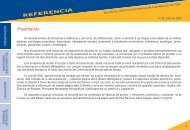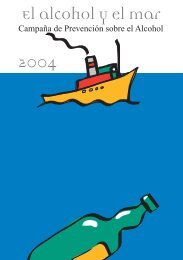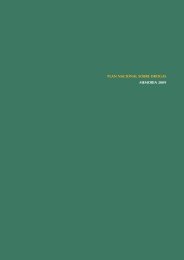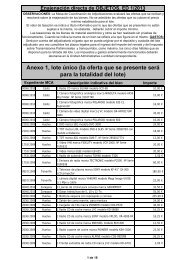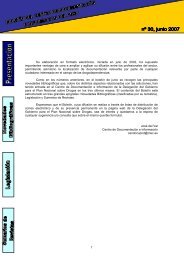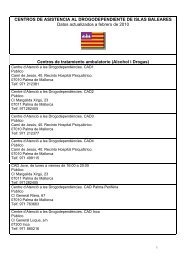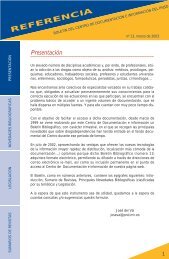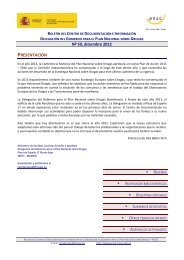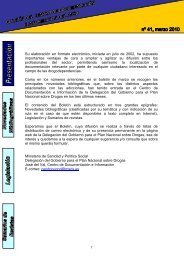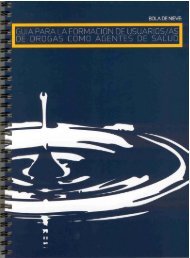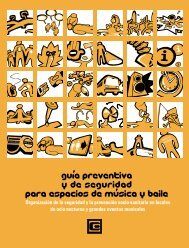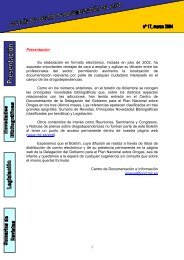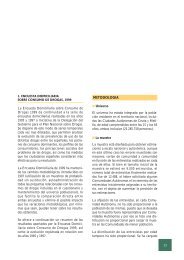Manual de adicciones para psicólogos - Plan Nacional sobre ...
Manual de adicciones para psicólogos - Plan Nacional sobre ...
Manual de adicciones para psicólogos - Plan Nacional sobre ...
- TAGS
- manual
- adicciones
- nacional
You also want an ePaper? Increase the reach of your titles
YUMPU automatically turns print PDFs into web optimized ePapers that Google loves.
7. Evaluación <strong>de</strong> los trastornos adictivosLeglèye, S., Karila, S., Beck, F. y Reynaud, M. (2007). Validation of the CAST, a general population CannabisAbuse Screening Test. Journal of Substance Abuse, 12, 233-242.Lesieur, H. R. y Blume, S. B. (1993). Revised the South Oaks Gambling Screen in different settings. Journalof Gambling Studies, 8, 213-223.Litman, G. K., Stapleton, J., Oppenheim, A. N. y Peleg, B. M. (1983). An instrument for measuring copingbehaviours in hospitalized alcoholics: Implications for relapse prevention and treatment. BritishJournal of Addiction, 78, 269-276.Llanero, M., Ruiz Sánchez <strong>de</strong> León, J. M., Pedrero, E., Olivar, A., Bouso, J. C., Rojo, G. y Puerta, C. (2008).Sintomatología disejecutiva en adictos a sustancias en tratamiento mediante la versión española<strong>de</strong>l Cuestionario Disejecutivo (DEX-Sp). Revista <strong>de</strong> Neurología, 47, 1-15.Llorente, J. M. (1997). Validación <strong>de</strong>l DTCQ-H a la población española “Cuestionario <strong>de</strong> confianza antesituaciones <strong>de</strong> riesgo <strong>de</strong> consumo <strong>de</strong> heroína”. Tesis Doctoral. Madrid: Universidad <strong>Nacional</strong> <strong>de</strong>Educación a Distancia.Llorente, J. M., Fernán<strong>de</strong>z, C. y Vallejo, M. A. (2002). Validación <strong>de</strong>l Cuestionario <strong>de</strong> Confianza anteSituaciones <strong>de</strong> Riesgo <strong>de</strong> Consumo <strong>de</strong> Drogas - Heroína (DTCQ-H) en población española. EnI. Iraurgui y F. González (Eds.), Instrumentos <strong>de</strong> evaluación en drogo<strong>de</strong>pen<strong>de</strong>ncias (pp. 435-478).Madrid: Ediciones Aula Médica.Lobo, A., Pérez-Echeverría, M. J. y Artal, J. (1986). Validity of the scaled version of the General HealthQuestionnaire (GHQ-28) in a Spanish population. Psychological Medicine, 16,135-140.López, A. y Becoña, E. (2006). El craving en personas <strong>de</strong>pendientes <strong>de</strong> la cocaína. Anales <strong>de</strong> Psicología, 22,205-211.Loranger, A. W. (1995). International Personality Disor<strong>de</strong>r Examination (IPDE). Ginebra: World HealthOrganization.Marlatt, A. y Gordon, J. (1985). Relapse prevention. Maintenance strategies in addictive behavior change.Nueva York: Guildford Press.Mars<strong>de</strong>n, J., Gossop, M., Stewart, D., Best, D., Farrell, M., Lehmann, P., Edwards, C. y Strang, J. (1998). TheMaudsley Addiction Profile (MAP): A brief instrument for assessing treatment outcome. Addiction,93, 1857-1867.Martin, G., Copeland, J., Gates, P. y Gilmour, S. (2006). The Severity of Depen<strong>de</strong>nce Scale (SDS) in anadolescent population of Cannabis users: Reliabity, validity and diagnostic cut-off. Drug and AlcoholDepen<strong>de</strong>nce, 83, 90-93.Martin, R. A., Rossi, J. S., Rosenbloom, D., Monti, P. M. y Rohsenow, D. J. (1992). Stages and processess ofchange for quitting cocaine. Póster presentado a la 26th Annual Convention of the Association forthe Advancement of Behaviour Therapy, Boston.138



